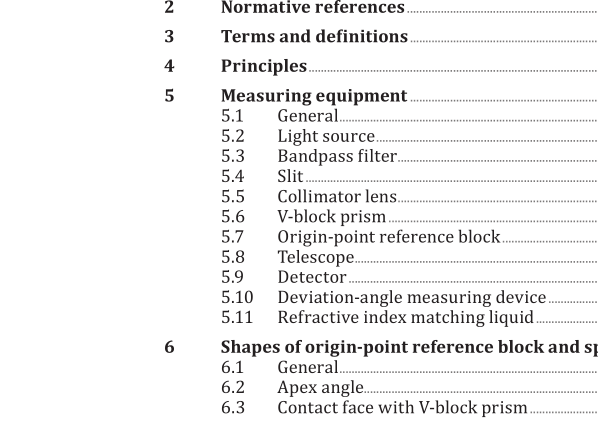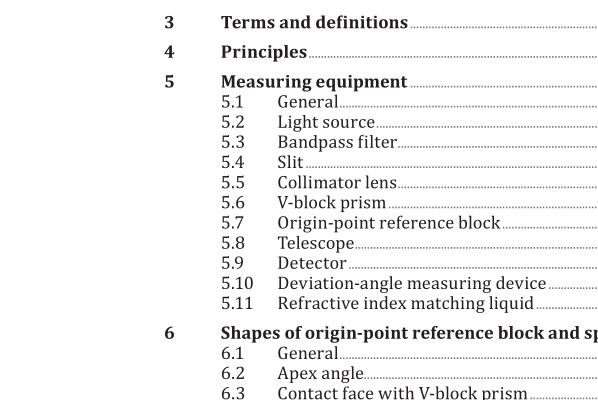ISO 21395-2:2022 pdf download – Optics and photonics — Test method for refractive index of optical glasses — Part 2: V-block refractometer method.
1 Scope This document specifies a method to determine the refractive index of optical glass with the accuracy within 3 × 10 -5 at the wavelength range from 365 nm to 2 400 nm by using the V-block refractometer method. While this document can be used for non-glass materials, the user is informed that only optical glass has been considered in the development of this document, and other materials can have issues, which have not been taken into consideration. 2 Normative references The following documents are referred to in the text in such a way that some or all of their content constitutes requirements of this document. For dated references, only the edition cited applies. For undated references, the latest edition of the referenced document (including any amendments) applies. ISO 280, Essential oils — Determination of refractive index ISO 9802, Raw optical glass — Vocabulary ISO 21395-1, Optics and photonics — Test method for refractive index of optical glasses — Part 1: Minimum deviation method ISO 80000-1, Quantities and units — Part 1: General ISO 80000-3, Quantities and units — Part 3: Space and time 3? Terms? and? definitions For the purposes of this document, the terms and definitions given in ISO 9802, ISO 80000-1, ISO 80000-3 and the following apply. ISO and IEC maintain terminological databases for use in standardization at the following addresses: — ISO Online browsing platform: available at https:// www .iso .org/ obp — IEC Electropedia: available at https:// www .electropedia .org/ 3.1 V-block prism prism manufactured from optical glass material with a known refractive index 3.2 refractive index matching liquid transparent liquid having the refractive index close to that of the specimen
NOTE In general, the symbol of the refractive index is the lowercase n. However, this document intentionally uses the capital letter N for the relative refractive index of the V-block prism to make it more distinct from that of the specimen. The sign of the deviation angle of the emergent beam shall be positive (+) for upward deviation (that is, n > N) and negative (−) for downward deviation (n < N) respectively, relative to the incident beam. Therefore, by measuring γ, n can be obtained by calculation. This principle is also applicable when the incident beam angle is controlled so that the emergent beam is perpendicular to the exit face of the V-block prism. Therefore, as shown in Figure 1b), it is also possible to calculate the refractive index based on the measurement result of the deviation angle of the incident beam to the emergent beam. 7.2.6 provides the formula for the calculation of n.
ISO 21395-2:2022 pdf download – Optics and photonics — Test method for refractive index of optical glasses — Part 2: V-block refractometer method






